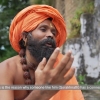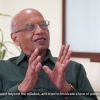'Cauraṅgi, Nāth siddha, from the caves at Panhale Kaji in Maharashtra'. Photo by Dr James Mallinson and Dr Daniela Bevilacqua, Haṭha Yoga Project.
Although meditative practices can be found in many (perhaps most) religious and spiritual traditions, as well as in more secular milieux in contemporary society, it is probably the religious traditions originating in India (Buddhism, Jainism and the various traditions which became known as Hinduism) with which meditation is most closely associated. The image of meditation most likely to be conjured up, at least by the non-practitioner, will be that of either the Buddha or of a yogin, in each case sitting in complete physical stillness, apparently with a quiet, calm mind reflected in his or her general demeanour.
In many ways, meditative practices, in which the aim is in some way to control and/or quieten the functioning of the mind, are both the real hallmark of the yoga traditions and the link between the diverse sets of practices which, over the centuries, have been given the name ‘yoga’. Probably the earliest usage of ‘yoga’ to designate a form of practice comes from the Kaṭha Upaniṣad, a text most likely compiled in around the 4th century BCE. There, yoga is defined as the ‘firm reining in’ of the senses and the mind, in order to free the practitioner from distractions (Katha Upanisad 6.11). In a similar way, the Śvetāśvatara Upaniṣad, probably from around the same period[1], speaks of a wise person ‘keeping his mind vigilantly controlled’ (Śvetāśvatara Upaniṣad 2.9), in a passage which elsewhere contains clear references to yoga. Yet, despite the antiquity of these roots, the major 20th /early 21st century Indian yoga teacher, B.K.S. Iyengar (who is often more commonly associated with his contributions to the teaching of yoga postures), is still able to say that: ‘Yoga is meditation, and meditation is yoga’ (Iyengar 2005:182).
We may reasonably ask why the compilers of these ancient texts considered the control of the mind to be desirable. The Upaniṣads of the late Vedic period in India (a group of texts compiled from around 700 BCE to the very early Common Era) emphasised a shift in religious thought from a focus on the performance of often complex and carefully choreographed ritual to the privileging of the power of knowledge, specifically knowledge of the ‘true’ nature of reality. That knowledge, it was thought, was most likely to be acquired not by letting the mind wander from place to place in the realm of materiality, but, rather, by bringing the mind to a state of calm control, a process which the Upaniṣads also sometimes acknowledged was more likely to be effective if it took place away from organised society. The Chāndogya Upaniṣad, from around 600 BCE, for example, speaks of those in the wilderness taking the ‘path to the gods’ at death, while those in the villages took the less desirable ‘path to the ancestors’ (Chāndogya Upaniṣad 5.10); the passage of the Śvetāśvatara Upaniṣad referred to above highlights the importance of practising mental control (and here a word cognate with the word ‘yoga’ is used) in an aesthetically pleasing environment, which is at least implicitly somewhat removed from society (Śvetāśvatara Upaniṣad 2.10). Ultimately, the goal of these practices was not simply the creation of mental stillness for its own sake, but the acquisition of the knowledge which would free the practitioner from the cycles of death and rebirth.
The extent to which the Upaniṣads specifically refer to the more systematic practices which we later call ‘meditation’ is a matter of debate. In many places, the early Upaniṣads use terms derived from the Sanskrit verbal root upa+ās, for example the nominal form upāsana. In certain systematic schools of Indian philosophy which came to prominence centuries later than the Upaniṣads, the term ‘upāsana’ denoted meditation practice. However, we need to exercise a degree of restraint in necessarily interpreting upāsana (or its related words) in the Upaniṣads as indicating meditation in any formal or systematic sense: upa+ās can also mean to ‘venerate’ or ‘worship’ and may not necessarily bring with it the specific connotation of mental control. However, the Sanskrit noun dhyāna, which becomes probably the most widely used Sanskrit term for meditation in the yoga traditions, and its related words, do appear in the Upaniṣads (albeit relatively infrequently and only in the later Upaniṣads), in contexts which seem fairly clearly to denote some form of practice. In the Praśna Upaniṣad, for example, the person who performs dhyāna on the sacred syllable OṂ is led beyond the realm of the living (in other words, beyond the cycle of death and rebirth).[2]
The term dhyāna is a significant term not just in the Upaniṣads, which were propagated within the ‘orthodox’ brahminical tradition in India, but also in the so-called śramaṇa (literally ‘striver’) movements which emerged in northern India from around the middle of the first millennium BCE. These movements (which included, amongst others, the early Buddhists and Jains) rejected the authority of the Vedic texts (including the Upaniṣads), but nevertheless sought techniques which would allow them to transcend the cycle of death and rebirth, again through the controlling (or ‘stopping’) of the functioning of the mind. In Buddhist circles, this process was sometimes expanded to include a realisation of the Four Noble Truths of Buddhism, through specific meditative practices (e.g. the abandonment of both pleasure and suffering) known as dhyāna.[3] The extent to which the teachings of the later Upaniṣads, such as the Kaṭha, Śvetāśvatara and Praśna, about mental control and yoga were influenced by the teachings and practices of these śramaṇa movements will probably never be known: it is, however, reasonable to point out that the later Upaniṣads were undoubtedly compiled in social and cultural environments in which interaction between the brahminical tradition and non-Vedic movements was taking place. Similarly, the great Indian epic the Mahābhārata, which too was probably compiled over a period spanning the late centuries BCE and the early centuries of the Common Era, refers to Buddhist practitioners of dhyānayoga and introduces a fourfold dhyānayoga practice, using terminology which suggests Buddhist influence (Mallinson and Singleton 2017: 288).
By the early centuries of the Common Era, a systematic practice of meditation had become the heart of the yogic method outlined in the Pātañjalayogaśāstra (‘PYS’).[4] In the well-known aṣṭāṅga (‘eight auxiliary’) yoga scheme of the PYS, dhyāna is the seventh auxiliary, forming part of a three-fold system of meditation in which it is preceded by dhāraṇā and followed by samādhi. This three-fold system, known collectively as saṃyama, is in turn preceded by ethical practices and, of most importance for our purposes, the placing of the physical body in a posture of steadiness and comfort (āsana), the control or restraint of breath (prāṇāyāma), and the disconnection of the senses from their external objects (pratyāhāra).[5]
In this system, once the physical body has been placed appropriately and the breath controlled, the disconnection of the senses from their external objects is an essential precursor. In other words, the practitioner should withdraw their attention from the sensations of sight, hearing, taste, touch and smell. For this reason, meditation in the yoga tradition is most commonly (unlike in certain Buddhist traditions) practised with the eyes closed, and undisturbed by (e.g.) the scent of incense or the sound of (external) mantra. Only after the disconnection of the senses does the practitioner begin the three stage meditation process by making their attention single-pointed, in other words fixing it on a single place (this fixation is dhāraṇā, Yoga Sūtra 3.1.). The PYS is remarkably liberal about where that place might be or what might occupy it: Sūtra 1.39 effectively leaves the choice entirely up to the practitioner, though the preparatory step of disconnecting the senses from their objects implies that it should be ‘internal’ rather than ‘external’. The commentarial part of the PYS suggests certain bodily locations, such as the navel or the tip of the nose, and, in practice, the locus of meditation might be one of these places, or may be a visualised image or internalised sound. A common form of meditation, used across a range of spiritual traditions, is japa (literally ‘muttering’), the silent, internal recitation of a mantra many times over until the mantra is ‘heard’ rather than consciously recited, and then ultimately is simply ‘present’ without any action on the part of the meditator.[6]
Dhyāna—meditation itself—arises when the focus of the practitioner’s awareness on the chosen place becomes continuous, i.e., without the interruptions which will inevitably arise in the first stage (Yoga Sūtra 3.2.). Eventually, dhyāna ‘matures’ into the final stage, samādhi, where the object of meditation ‘shines forth’ free of the subjective perception of the meditator.[7] Mastery of this three-stage process, according to the PYS, leads to the gaining of ‘insight’ (prajñā), and, depending on the chosen object of meditation, certain ‘supernatural’ powers, such as knowledge of the movements of the stars, acquisition of the powers of an elephant, or even omniscience, are said to arise.
In the tantric yoga traditions, which grew from perhaps the sixth century CE onwards, meditation continues to play a central role. In these traditions, however, there tends to be less liberality about the focus of meditation. Rather, the various tantric schools prescribe for their initiates a range of often very detailed and sophisticated visualisation practices. These generally begin with focus on the five great elements (earth, water, fire, air and space), often accompanied by internal visualisation of associated symbols, images, or deities and/or by internal repetition of ‘seed’ (bījā) sounds or syllables, as a way of ‘mastering’ the element in question. They often then progress to meditations on one or more of the deities of the tantric tradition in question. Here, the ultimate goal is less conceived of as either the acquisition of liberative knowledge or (as in the PYS) kaivalya—the realisation of the ultimate separateness of consciousness from the world of materiality. Rather, in most tantric traditions, the goal is conceived of as ‘uniting with’ or ‘becoming’ the deity itself. As in the saṃyama process of the PYS, in the tantric traditions special powers are often said to arise on the meditative path.
Meditation continues to play an important role in the tradition of haṭhayoga, from around the 11th or 12th century. Here, tantric models of the ‘yogic body’, most notably the system of cakras (‘wheels’, or internal energy centres) are frequently invoked as focal points, but there is no requirement for the complex initiation procedures of the tantric schools. Meditation in haṭhayoga is generally seen as requiring the practice of āsana (by now an expanded set of specific postures), prāṇāyāma and mudrā/bandha as precursors. The haṭhayoga texts, in general, do not elaborate on the actual process of meditation in great detail, though their common adoption of terminology from the PYS suggests an approval of the general process outlined there. The haṭhayoga texts bring in a variety of specific meditative techniques, amongst them the practice of focussing on internal sound (nāda), in which, by a process of ‘hearing’ ever more subtle sounds, the practitioner ends up focussing on the ‘unstruck’ (anāhata) sound (Haṭhapradīpikā 4.82–4.89). This, in turn, is said to lead to laya (‘dissolution’), in which both sound and mind dissolve—a state often equated with samādhi, which remains the end point of the process.[8]
In much (though not all) contemporary yoga practice, meditation takes a back seat to the practice of postures, and perhaps to the breathing practices of prāṇāyāma. Relatively few contemporary yoga classes give meditation a significant role, and many that do tend to treat it as an add-on to āsana, not an integral part of the overall yoga practice. It is probably also fair to say that many meditative practices which do feature in contemporary yoga classes owe their origins more to Buddhist traditions of meditation than they do to the methods of the PYS or the tantric or haṭhayoga traditions. The success of ‘mindfulness’ as a ‘secular’ form of meditative practice (although ultimately with Buddhist origins) has tended to overshadow the more specific techniques which have flowed through the yoga traditions. While one can understand a degree of caution in relation to the tantric practices, with their requirement for initiation into a specific lineage, there is no obvious reason why the meditative approaches of the PYS and of the haṭhayoga texts should not play a much more prominent role in contemporary yoga. There are, of course, many honourable exceptions, and some encouraging signs: in the contemporary yoga world we may yet find ourselves return to a place where ‘Yoga is meditation, and meditation is yoga’ (Iyengar 2005:182).
Notes
[1] Though some put it significantly later—see Mallinson and Singleton 2017:xxxix.
[2] Praśna Upaniṣad 5.5, probably from the very beginning of the Common Era.
[3] Mallinson and Singleton 2017: 288–89, and the sources cited there.
[4] This is an umbrella term now commonly used to denote the text often referred to as the Yoga Sūtra together with its principal commentary, attributed to ‘Vyāsa’. Philipp Maas has argued that the sūtra text and the ‘Vyāsa’ commentary are most likely the unified work of a single author, which came into its present form between around 325 and 425 CE, though certain of its contents may be older (Maas 2013).
[5] Yoga Sūtra 2.29. Cf. the ‘reining in’ of the senses referred to in the Kaṭha Upaniṣad. The relationship between state of breath and state of mind was understood at least at the time of the early Upaniṣads: see Chāndogya Upaniṣad 6.8.2, Kauṣītaki Upaniṣad 2.1 (where the mind is described as the ‘messenger of the breath’).
[6] There are several place in ancient Indian texts where ‘internalised’ sound is said to be many times more powerful than sound uttered out loud, or even whispered, an example is Mānavadharmaśāstra 2.85. Yoga Sūtra 1.28 refers to the practice of japa of the syllable OṂ as a way of ‘turning consciousness inwards’.
[7] Yoga Sūtra 3.3. Elsewhere, the PYS divides samādhi into two principal types: in the first, said to be ‘with seed’, some or all of the states of attention (vitarka), reflection (vicāra), bliss (ānanda) and self-identity (asmitā) remain present in the practitioner; in the second, ‘without seed’, there is a complete dropping away of the cognitive functions, and therefore of the object of meditation, resulting in the cessation of production of karmic ‘seeds’.
[8] Even though characterised somewhat differently in haṭhayoga than in the PYS: see Mallinson and Singleton 2017:327–30.
References
Akers, Brian Dana, tr. 2002. The Haṭha Yoga Pradīpikā. Woodstock: Yoga Vidya.
Bryant, Edwin, tr. and commentary. 2009. The Yoga Sūtras of Patañjali. New York: North Point Press.
Iyengar, B.K.S. 2005. Light on Life. London: Rodale.
Maas, Philipp. 2013. ‘A Concise Historiography of Classical Yoga Philosophy’, in Periodization and Historiography of Indian Philosophy, ed. Eli Franco. Vienna: Sammlung de Nobili, Institut für Südasien-, Tibet- und Buddhismuskunde der Universität Wien, pp. 53–90.
Mallinson, James and Mark Singleton eds. 2017. Roots of Yoga. London: Penguin Random House.
Olivelle, Patrick, tr. 1998. The Early Upaniṣads: Annotated Text and Translation. Oxford: Oxford University Press.
Sovik, Rolf. 2005. Moving Inward: The Journey to Meditation. Honesdale: The Himalayan International Institute of Yoga Science.













